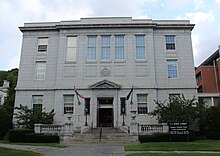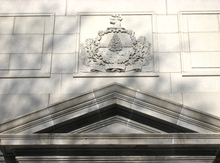| Vermont Supreme Court | |
|---|---|
 Seal of the Vermont Supreme Court Seal of the Vermont Supreme Court | |
| 44°15′42″N 72°34′47″W / 44.26166°N 72.57975°W / 44.26166; -72.57975 | |
| Established | 1782; 243 years ago (1782) |
| Jurisdiction | Vermont |
| Location | Montpelier |
| Coordinates | 44°15′42″N 72°34′47″W / 44.26166°N 72.57975°W / 44.26166; -72.57975 |
| Authorised by | Vermont Constitution |
| Appeals to | Supreme Court of the United States |
| Number of positions | 5 |
| Website | Official website |
| Chief Justice | |
| Currently | Paul L. Reiber |
| Since | December 17, 2004 |
The Vermont Supreme Court is the highest judicial authority of the U.S. state of Vermont. Unlike most other states, the Vermont Supreme Court hears appeals directly from the trial courts, as Vermont has no intermediate appeals court.
The Court consists of a chief justice and four associate justices; the Court mostly hears appeals of cases that have been decided by other courts. The Supreme Court justices are appointed by the Governor of Vermont with confirmation by the Vermont Senate. When a judicial vacancy occurs, the judicial nominating board submits to the governor the names of as many persons as it deems qualified for appointment. All Supreme Court justices come up for retention at the same time every six years. The next retention date is March 31, 2029. The Joint Committee on Judicial Retention reviews a justice's performance during the previous term and recommends to the Vermont General Assembly whether the justice should be retained. The committee consists of four House members appointed by the Speaker of the House and four Senate members appointed by the Committee on Committees. After open debate and discussion, the General Assembly votes by secret ballot, with a majority having to vote against reappointment for a justice to be denied another term.
In addition to the retention process, any Vermont judge may be removed at any time in one of two ways: (1) Judges may be impeached by a two-thirds vote of the General Assembly and convicted by a two-thirds vote of the Senate, and (2) a Judicial Conduct Board investigates complaints of judicial misconduct or disability and recommends any necessary action to the Supreme Court. Members of the Judiciary of Vermont must retire at the age of 90.
The current chief justice is Paul L. Reiber. Reiber was appointed Associate Justice in October 2003 by Gov. Jim Douglas and then sworn in as the Chief Justice of the Court on December 17, 2004.
The Vermont Supreme Court has overall administrative control of the court system and makes administrative and procedural rules for all courts.
Building



The Vermont Supreme Court meets in a granite Beaux Arts-style building in Montpelier, just east of the Vermont State House and immediately west of The Pavilion Office Building.
The building site was the original site of the first Vermont State Building, a three-story wooden colonial Georgian structure, built in 1808 by Sylvanus Baldwin.
Composition
Main article: List of justices of the Vermont Supreme Court| Justice | Born | Joined | Term ends | Appointed by | Law school |
|---|---|---|---|---|---|
| Paul Reiber, Chief Justice | (1947-06-20) June 20, 1947 (age 77) | October 2003 | 2029 | Jim Douglas (R) | Suffolk |
| Harold Eaton Jr. | (1955-08-25) August 25, 1955 (age 69) | October 27, 2014 | 2029 | Peter Shumlin (D) | Vermont |
| Karen Carroll | (1963-02-07) February 7, 1963 (age 61) | April 26, 2017 | 2029 | Phil Scott (R) | Vermont |
| William D. Cohen | (1957-01-21) January 21, 1957 (age 67) | December 20, 2019 | 2029 | Phil Scott (R) | Vermont |
| Nancy Waples | (1960-10-07) October 7, 1960 (age 64) | April 15, 2022 | 2029 | Phil Scott (R) | St. John's |
- Became Chief Justice on December 17, 2004.
History
The original constitution called for a "Council of Censors" which provided oversight for the court and its membership. The Council was abolished in 1870.
Prominent individuals who have served as Chief Justice include Governor and United States Senator Moses Robinson; Senator Nathaniel Chipman; Governor and Senator Isaac Tichenor; Governor and Senator Jonathan Robinson; playwright Royall Tyler; Governor Richard Skinner; Senator Dudley Chase; Governor Cornelius P. Van Ness; Senator Samuel Prentiss; Governor Charles K. Williams; Governor Stephen Royce; Congressman Luke P. Poland; Congressman Homer Royce; Senator Jonathan Ross; and U.S. District Court Judge Franklin S. Billings Jr.
Olin M. Jeffords, the father of Senator James M. Jeffords, served as Chief Justice from 1955 to 1958.
References
- "Supreme Court | Vermont Judiciary". www.vermontjudiciary.org. Retrieved October 13, 2018.
- "Judicial Nomination Board". April 17, 2022.
- "The Vermont Statutes Online: Title 4: Judiciary". Vermont General Assembly.
- "Judicial Retention Committee". April 17, 2022.
- "Removal of Justices". April 17, 2022.
- "Mandatory Retirement". Ballotpedia.org. Middleton, WI: Lucy Burns Institute. Retrieved July 29, 2020.
- "Reiber appointment to Associate Justice (2003), then to Chief Justice (2004)". Archived from the original on August 12, 2007. Retrieved May 10, 2007.
- "Archived copy" (PDF). Archived from the original (PDF) on August 24, 2015. Retrieved February 6, 2015.
{{cite web}}: CS1 maint: archived copy as title (link) - Gillies, Paul, ed. (1991). Records of the Council of Censors of the State of Vermont (PDF).
External links
| Highest judicial bodies in the United States | |
|---|---|
| Federal courts | |
| State supreme courts |
|
| Territorial supreme courts | |
| Obsolete | |
| Complete list |
|